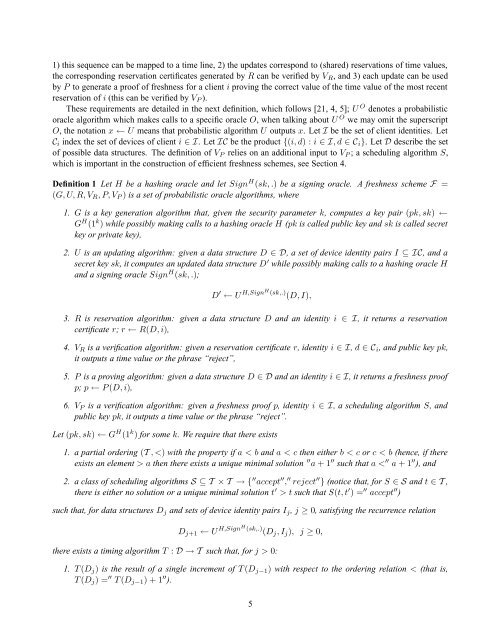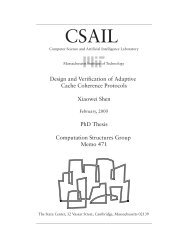Proof of Freshness - Computation Structures Group - MIT
Proof of Freshness - Computation Structures Group - MIT
Proof of Freshness - Computation Structures Group - MIT
You also want an ePaper? Increase the reach of your titles
YUMPU automatically turns print PDFs into web optimized ePapers that Google loves.
1) this sequence can be mapped to a time line, 2) the updates correspond to (shared) reservations <strong>of</strong> time values,<br />
the corresponding reservation certificates generated by R can be verified by VR, and 3) each update can be used<br />
by P to generate a pro<strong>of</strong> <strong>of</strong> freshness for a client i proving the correct value <strong>of</strong> the time value <strong>of</strong> the most recent<br />
reservation <strong>of</strong> i (this can be verified by VP ).<br />
These requirements are detailed in the next definition, which follows [21, 4, 5]; U O denotes a probabilistic<br />
oracle algorithm which makes calls to a specific oracle O, when talking about U O we may omit the superscript<br />
O, the notation x ← U means that probabilistic algorithm U outputs x. Let I be the set <strong>of</strong> client identities. Let<br />
Ci index the set <strong>of</strong> devices <strong>of</strong> client i ∈ I. Let IC be the product {(i, d) : i ∈ I, d ∈ Ci}. Let D describe the set<br />
<strong>of</strong> possible data structures. The definition <strong>of</strong> VP relies on an additional input to VP ; a scheduling algorithm S,<br />
which is important in the construction <strong>of</strong> efficient freshness schemes, see Section 4.<br />
Definition 1 Let H be a hashing oracle and let Sign H (sk, .) be a signing oracle. A freshness scheme F =<br />
(G, U, R, VR, P, VP ) is a set <strong>of</strong> probabilistic oracle algorithms, where<br />
1. G is a key generation algorithm that, given the security parameter k, computes a key pair (pk, sk) ←<br />
G H (1 k ) while possibly making calls to a hashing oracle H (pk is called public key and sk is called secret<br />
key or private key),<br />
2. U is an updating algorithm: given a data structure D ∈ D, a set <strong>of</strong> device identity pairs I ⊆ IC, and a<br />
secret key sk, it computes an updated data structure D ′ while possibly making calls to a hashing oracle H<br />
and a signing oracle Sign H (sk, .);<br />
D ′ ← U H,SignH (sk,.) (D, I),<br />
3. R is reservation algorithm: given a data structure D and an identity i ∈ I, it returns a reservation<br />
certificate r; r ← R(D, i),<br />
4. VR is a verification algorithm: given a reservation certificate r, identity i ∈ I, d ∈ Ci, and public key pk,<br />
it outputs a time value or the phrase “reject”,<br />
5. P is a proving algorithm: given a data structure D ∈ D and an identity i ∈ I, it returns a freshness pro<strong>of</strong><br />
p; p ← P (D, i),<br />
6. VP is a verification algorithm: given a freshness pro<strong>of</strong> p, identity i ∈ I, a scheduling algorithm S, and<br />
public key pk, it outputs a time value or the phrase “reject”.<br />
Let (pk, sk) ← G H (1 k ) for some k. We require that there exists<br />
1. a partial ordering (T , a then there exists a unique minimal solution ′′ a + 1 ′′ such that a < ′′ a + 1 ′′ ), and<br />
2. a class <strong>of</strong> scheduling algorithms S ⊆ T × T → { ′′ accept ′′ , ′′ reject ′′ } (notice that, for S ∈ S and t ∈ T ,<br />
there is either no solution or a unique minimal solution t ′ > t such that S(t, t ′ ) = ′′ accept ′′ )<br />
such that, for data structures Dj and sets <strong>of</strong> device identity pairs Ij, j ≥ 0, satisfying the recurrence relation<br />
Dj+1 ← U H,SignH (sk,.) (Dj, Ij), j ≥ 0,<br />
there exists a timing algorithm T : D → T such that, for j > 0:<br />
1. T (Dj) is the result <strong>of</strong> a single increment <strong>of</strong> T (Dj−1) with respect to the ordering relation < (that is,<br />
T (Dj) = ′′ T (Dj−1) + 1 ′′ ).<br />
5
















